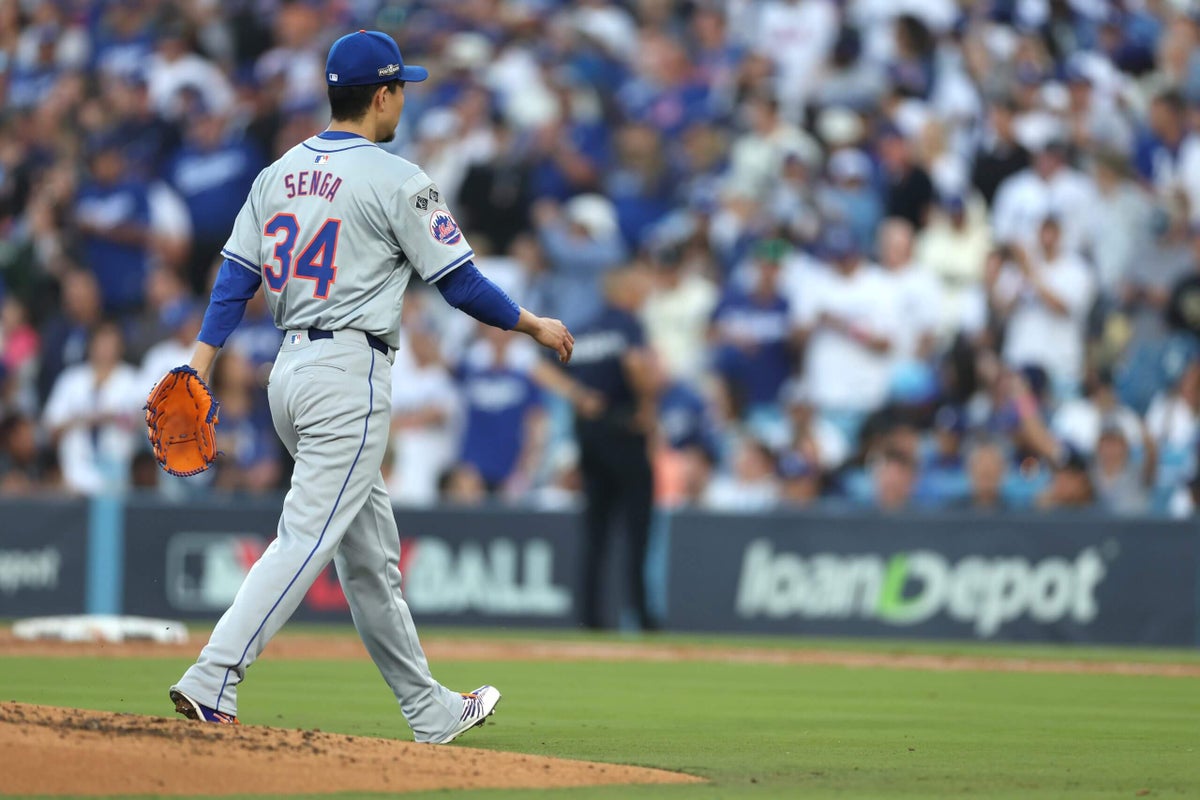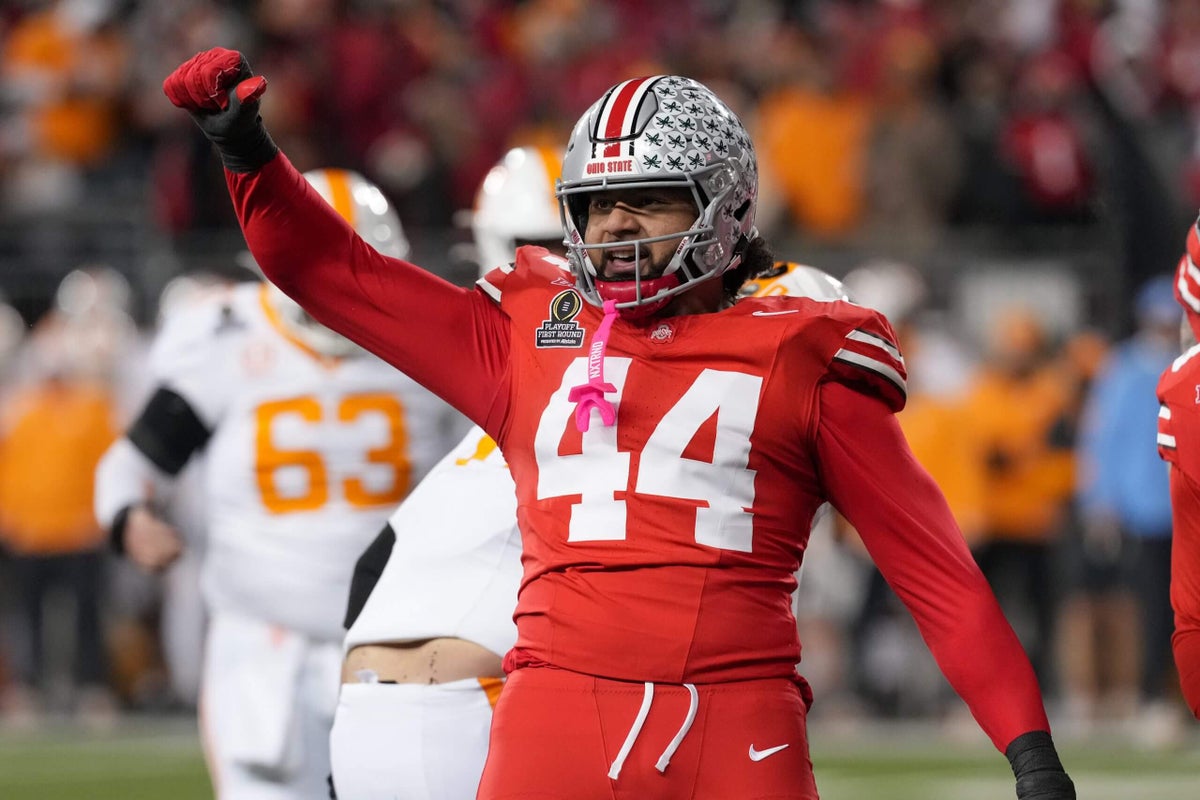LOS ANGELES — Whatever team-of-destiny aura the New York Mets had accumulated over the past few weeks was punctured in a demoralizing 9-0 loss to the Los Angeles Dodgers on Sunday night. The Mets looked overmatched going against baseball’s best team, submitting one of their sloppiest performances in months.
No, Game 1 in Los Angeles could not have gone much worse for New York. In the span of nine regrettable innings, the Mets:
- Lost the game
- Developed questions about Kodai Senga’s ability to start a Game 5
- Used David Peterson, Reed Garrett and José Buttó for multiple innings
- Allowed Jack Flaherty to cover seven innings, meaning the Dodgers needed just two relievers, including a low-leverage long man, ahead of a bullpen game in Game 2
- Extended Los Angeles’ scoreless inning streak to 33, tying a postseason record
“We’ve got to figure out a way to come back (Monday) and play better,” Francisco Lindor said.
Indeed, the Mets were barely recognizable Sunday night, falling behind in counts, issuing free passes, committing errors and running into outs. You’ve heard stories of a Mets team that played like this, sometime in the distant past of another era — called May 2024.

Francisco Lindor and the Mets had a rough night at the plate, managing just three hits — all singles. (Harry How / Getty Images)
It started with Senga on the mound. If not the outstanding version of himself he’d shown in his lone regular-season start in July, Senga had been a viable pitcher in his prior postseason outing against the Phillies. Not so Sunday night.
After retiring Shohei Ohtani to start the game, Senga walked Mookie Betts on four pitches, and Freddie Freeman on six pitches, and Teoscar Hernández on four pitches. Many of those offerings were not particularly close, with his trademark forkball, specifically, starting uncompetitively below the strike zone.
Still, Senga moved within an out of escaping unscathed before Max Muncy looped a 2-1 cutter to center to drive in two runs with two outs.
Despite throwing just seven of his 23 first-inning pitches for strikes, Senga came back for the second. He walked Gavin Lux on five pitches to start and, after Ohtani drove home another run with a ground-ball single through the right side, his night was over.
“He was off. He didn’t have it,” manager Carlos Mendoza said.
“You could see clearly that Senga just didn’t have his A stuff tonight,” Dodgers manager Dave Roberts said. “He was just relying on the cutter, working behind hitters, walking guys.”
Six of the 10 batters Senga faced reached and three of them scored. He recorded four outs, and only 10 of the 30 pitches he threw were for strikes. No pitcher in the history of the postseason had thrown as many pitches in a game with such a small percentage of them for strikes.
“Obviously, I’m frustrated and disappointed,” Senga said through interpreter Hiro Fujiwara, adding that he just couldn’t fix faulty mechanics. “I was definitely thinking about my mechanics because when they’re not there, it’s hard to compete.”
Given how rough this outing was, it’s reasonable to wonder if Senga deserves another one. The Mets haven’t committed to a rotation for the rest of the series, but the ideal plan would have Senga start a Game 5 in Queens on Friday.
“We’ve got to wait and see how he responds the next couple of days, the same way that we’ve been treating it every time he gets on the mound,” Mendoza said. “Day by day, and then we’ll see how we get to Game 5 or whatever the case might be.”
“I don’t know when I’m pitching next, but my job is to adjust and focus on what I need to do to make the next outing better,” Senga said.
Mendoza and the Mets decided a 3-0 deficit that early was worth chasing, and so they used David Peterson for length in the middle of the game rather than Tylor Megill. A standout so far this postseason, Peterson got hit around for three more runs in the fourth inning, eventually throwing 40 pitches in 2 1/3 frames. He could be back to pitch as a reliever for Game 3 or become a candidate to replace Senga in Game 5, should the Mets find that necessary.
The Mets’ offense could do nothing, though, against Flaherty. He retired the first nine and escaped a two-on jam in the fourth when Starling Marte’s fly ball to right died on the warning track. When the first two Mets singled in the fifth, Jesse Winker ran into the first out of the inning at third.
“It was just a really bad play by me,” Winker said.
Afterward, the Mets expressed no panic. They didn’t have to lean on their recent refrain about overcoming adversity; their robust track record in that regard speaks for itself. They’ve been 0-5, they’ve been 11 under, they’ve been down to the last two outs of their season. A 1-0 deficit in a best-of-seven barely registers.
That’s true of their history, too: New York played 11 prior best-of-seven series, and it’s been more successful after losing Game 1 (3-3) than after winning it (2-3).
“The energy of this team is still there,” Marte said through interpreter Alan Suriel. “It’s going to be a long series.”
(Photo of Kodai Senga: Sean M. Haffey / Getty Images)














Leave a Reply